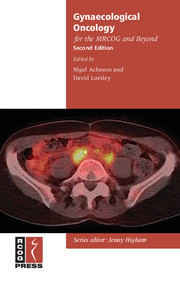Book contents
- Frontmatter
- Contents
- About the authors
- Preface
- Introduction to the second edition
- Abbreviations
- 1 Basic epidemiology
- 2 Basic pathology of gynaecological cancer
- 3 Preinvasive disease of the lower genital tract
- 4 Radiological assessment
- 5 Surgical principles
- 6 Role of laparoscopic surgery
- 7 Radiotherapy: principles and applications
- 8 Chemotherapy: principles and applications
- 9 Ovarian cancer standards of care
- 10 Endometrial cancer standards of care
- 11 Cervical cancer standards of care
- 12 Vulval cancer standards of care
- 13 Uncommon gynaecological cancers
- 14 Palliative care
- 15 Emergencies and treatment-related complications in gynaecological oncology
- Appendix 1 FIGO staging of gynaecological cancers
- Index
2 - Basic pathology of gynaecological cancer
Published online by Cambridge University Press: 05 August 2014
- Frontmatter
- Contents
- About the authors
- Preface
- Introduction to the second edition
- Abbreviations
- 1 Basic epidemiology
- 2 Basic pathology of gynaecological cancer
- 3 Preinvasive disease of the lower genital tract
- 4 Radiological assessment
- 5 Surgical principles
- 6 Role of laparoscopic surgery
- 7 Radiotherapy: principles and applications
- 8 Chemotherapy: principles and applications
- 9 Ovarian cancer standards of care
- 10 Endometrial cancer standards of care
- 11 Cervical cancer standards of care
- 12 Vulval cancer standards of care
- 13 Uncommon gynaecological cancers
- 14 Palliative care
- 15 Emergencies and treatment-related complications in gynaecological oncology
- Appendix 1 FIGO staging of gynaecological cancers
- Index
Summary
Introduction
The cellular pathologist plays an important role as a diagnostician and in providing prognostic information by examination of specimens removed for diagnosis and definitive surgery for gynaecological cancers. The pathologist is an essential member of the multidisciplinary team and, through discussion with other team members, helps in formulating important management decisions. This section describes the salient features that would enable the gynaecologist to aid and understand the pathologist in this process.
Sending specimens to the laboratory
FIXATION
Most specimens are sent to the laboratory in fixative, most commonly 10% formalin (4% formaldehyde) solution. Fixation serves to:
• harden tissue to allow sectioning
• preserve tissue by preventing autolysis
• inactivate infectious agents
• enhance avidity for dyes.
The requesting clinician can aid the pathologist by sending the tissue in adequate fixative (10–15 times in volume relative to size of tissue) and by opening large specimens along anatomical planes, thus allowing penetration of fixative.
THE REQUEST FORM
The form accompanying the specimen contains vital details, such as patient details, to prevent misidentification and to prevent serious errors, as well as clinical details, with contact information.
Keywords
- Type
- Chapter
- Information
- Gynaecological Oncology for the MRCOG and Beyond , pp. 15 - 34Publisher: Cambridge University PressPrint publication year: 2011

